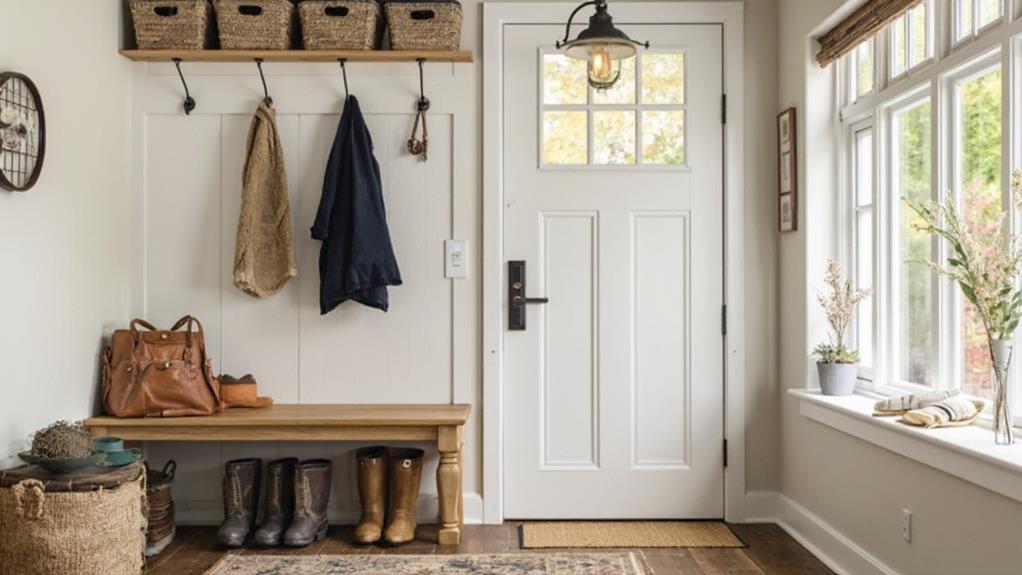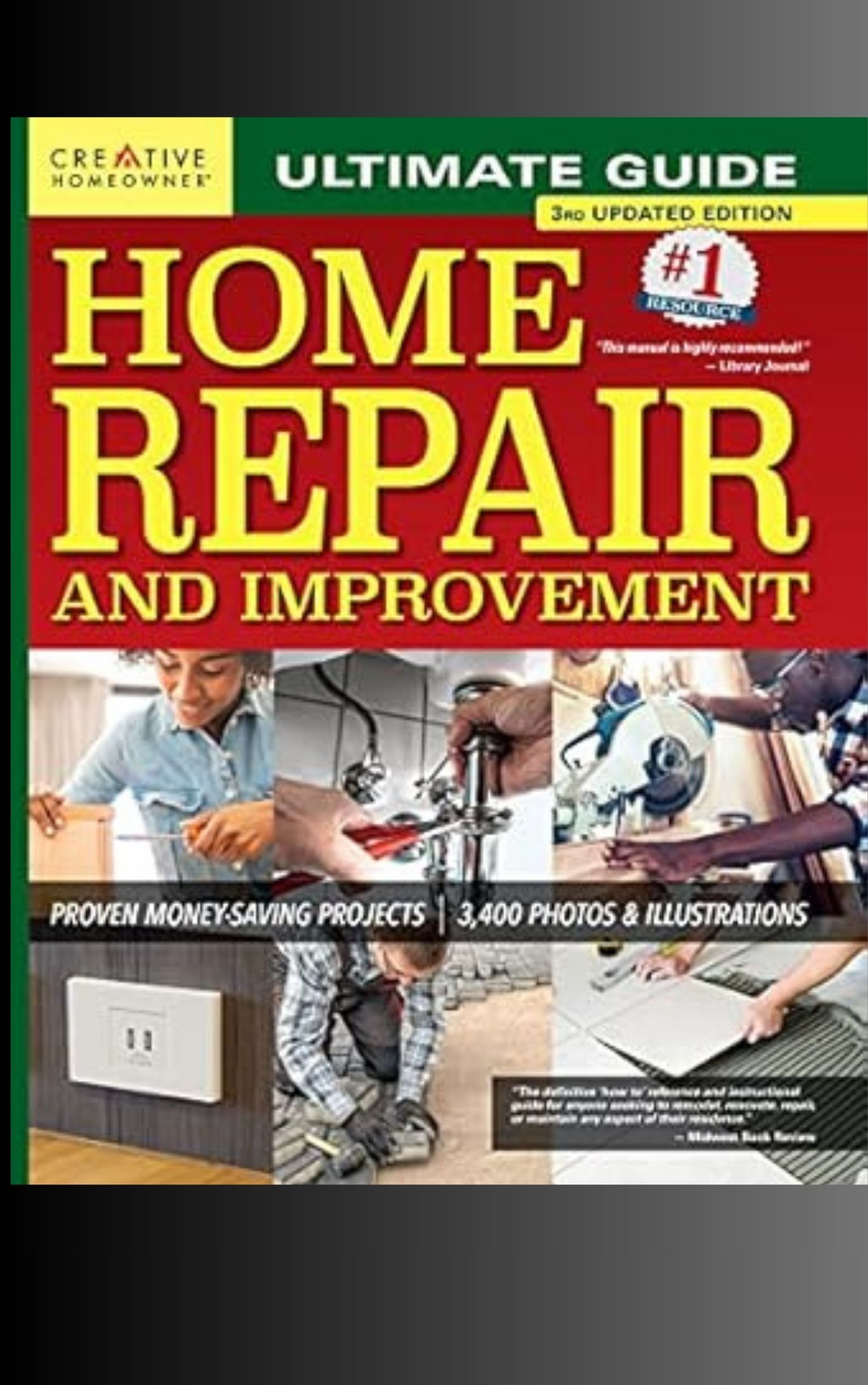Creating a functional mudroom on a budget starts with assessing your space and maximizing vertical storage. Utilize multi-functional furniture like storage benches and wall-mounted solutions to save floor space. DIY projects, such as repurposing wooden crates or mason jars, can add personalized storage options. Establish designated zones for shoes, coats, and daily essentials to maintain organization. Incorporate stylish elements like decorative baskets or vintage items to enhance aesthetics. Consider affordable flooring options like LVT or laminate for durability and easy maintenance. Strategic lighting choices, including energy-efficient LEDs and task lighting, complete the functional design. Discover how these budget-friendly tips can transform your entryway into a practical mudroom miracle.
Assess Your Space
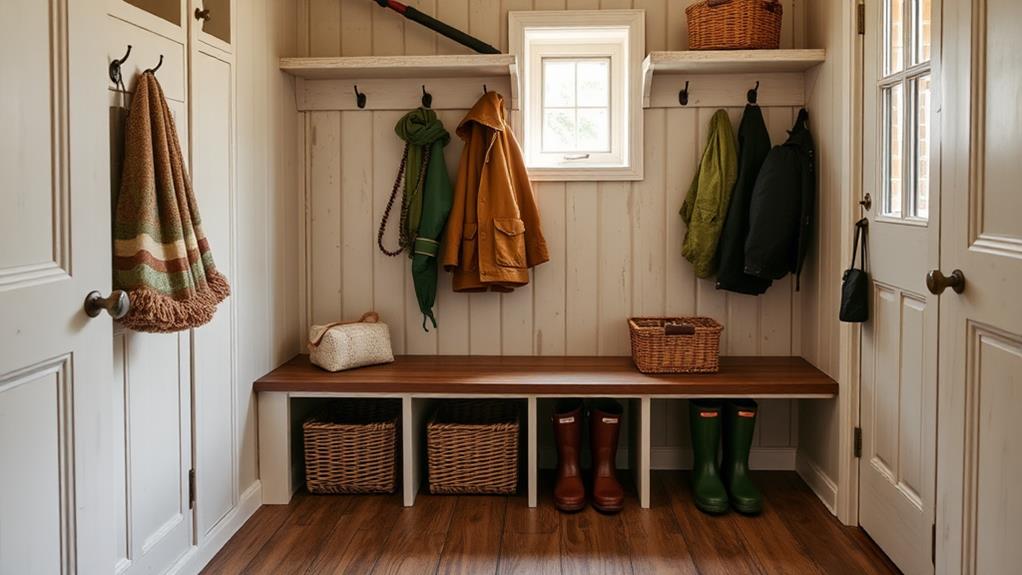
Assessing your entryway is the crucial first step in creating a functional space on a budget. Begin by measuring the available area, including width, length, and height. Take note of any architectural features, such as windows, doors, or electrical outlets, that may impact your design choices. Consider the traffic flow through the space and identify potential bottlenecks or congestion points.
Evaluate your storage needs by taking inventory of items typically brought into the home, such as shoes, coats, bags, and keys. Determine which items require immediate access and which can be stored away. Assess the natural light in the area and consider how it may affect your color choices and lighting requirements.
Examine the existing flooring and wall conditions to determine if any repairs or updates are necessary. Look for opportunities to maximize vertical space, such as utilizing wall-mounted storage solutions. Consider the climate in your area and how it might influence your entryway needs, such as space for wet umbrellas or bulky winter gear. By thoroughly assessing your space, you can make informed decisions about layout, storage solutions, and design elements that will create a functional entryway within your budget constraints.
Maximize Vertical Storage
With a clear understanding of your entryway's dimensions and needs, the next step is to make the most of your vertical space. Utilizing wall space efficiently can dramatically increase storage capacity without consuming precious floor area. Install floating shelves at varying heights to accommodate items of different sizes, from shoes to bags and accessories. Consider adding hooks or pegs beneath the shelves for coats, scarves, and keys.
Over-the-door organizers offer an often-overlooked storage solution. These versatile units can hold shoes, small accessories, or even cleaning supplies. For a more permanent option, mount a pegboard and customize it with hooks, small baskets, and shelves to create a flexible storage system that can evolve with your needs.
Tall, narrow cabinets or bookcases can provide substantial storage in a small footprint. Look for units with adjustable shelves to maximize versatility. If budget allows, consider custom-built floor-to-ceiling cabinets to fully utilize the vertical space. For renters or those on a tight budget, tension rods between walls can create instant hanging space for lightweight items. By thinking vertically, you can transform even the smallest entryway into a highly functional space.
Choose Multi-Functional Furniture
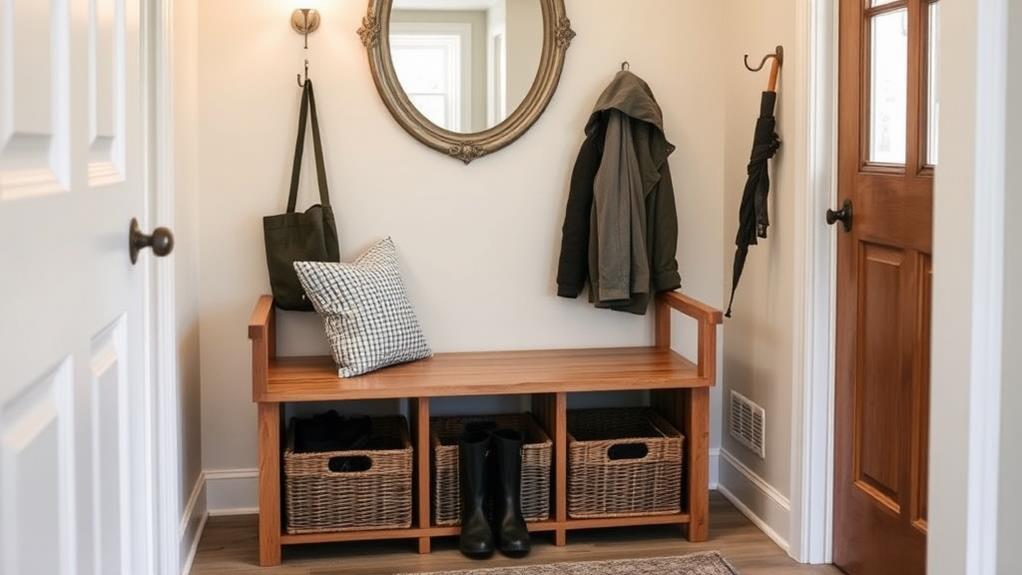
Multi-functional furniture is the entryway's secret weapon for maximizing space and utility on a budget. These versatile pieces serve multiple purposes, reducing clutter and optimizing limited square footage. Consider a storage bench with built-in cubbies or drawers, providing seating and organization in one compact unit. This allows family members to sit while putting on shoes while storing seasonal accessories underneath.
Wall-mounted folding tables or desks can serve as temporary workstations or catch-all surfaces for mail and keys, folding away when not in use. Look for coat racks with integrated shelving or mirror combinations to create a functional vignette. Stackable storage cubes offer customizable solutions, doubling as seating or display surfaces while housing shoes, bags, or sports equipment.
Ottomans with hidden storage compartments provide extra seating and concealed space for rarely used items. Consider repurposing a dresser as a console table, utilizing drawers for organized storage of gloves, scarves, and other small accessories. By selecting furniture that serves multiple functions, you can create a highly efficient entryway without breaking the bank or sacrificing style.
DIY Storage Solutions
While multi-functional furniture offers excellent storage options, creating your own DIY storage solutions can further maximize space and savings in your entryway. Consider repurposing everyday items to craft unique storage solutions that fit your specific needs and budget.
Transform wooden crates into wall-mounted cubbies for shoes, bags, and accessories. Sand, paint, and securely attach them to the wall for an industrial-chic look. Repurpose mason jars as organizers for small items like keys and coins by attaching them to a wooden board with pipe clamps.
Install a pegboard system for versatile storage. Use hooks, baskets, and shelves to create a customizable organization solution that can adapt to changing needs. Construct a simple bench with built-in storage using plywood and basic tools, providing seating and concealed space for seasonal items.
Upcycle old drawers into floating shelves by mounting them on the wall, offering both display and storage opportunities. Create a coat rack using reclaimed wood and vintage doorknobs or hooks for a charming, budget-friendly solution. These DIY projects not only save money but also add personal flair to your entryway.
Create Designated Zones
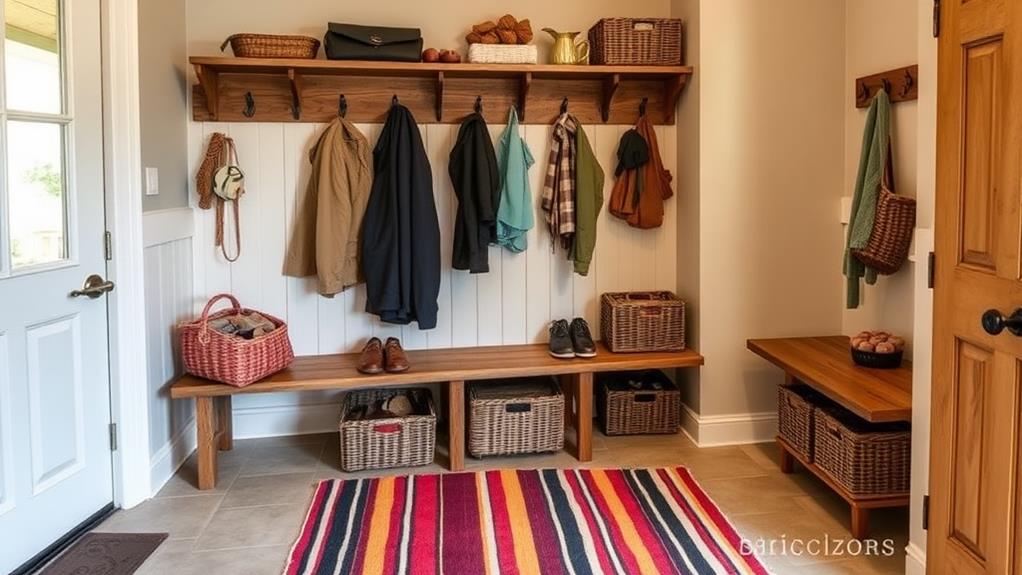
Organize your entryway by creating designated zones for specific functions, optimizing both space and efficiency. Begin by identifying essential activities that occur in your entryway, such as shoe removal, coat hanging, and key storage. Allocate distinct areas for each purpose, ensuring a logical flow of movement.
For shoe storage, designate a low-profile bench or shoe rack near the entrance. Install hooks or a slim coat rack above for outerwear, maximizing vertical space. Create a "drop zone" for keys, mail, and small items using a wall-mounted shelf or compact console table. If space allows, incorporate a seating area for putting on shoes or setting down bags.
Consider implementing a message center with a small bulletin board or chalkboard for family communications. For homes with children, establish a backpack station with individual hooks and cubbies. Use color-coding or labels to personalize each family member's space. In tighter spaces, opt for multi-functional furniture pieces that serve dual purposes, such as a storage bench that provides seating and concealed storage. By thoughtfully organizing your entryway into distinct zones, you'll create a more functional and streamlined space that meets your household's specific needs.
Incorporate Stylish Organization
Beyond functionality, stylish organization solutions can elevate your entryway's aesthetic appeal while maintaining a budget-friendly approach. Consider incorporating decorative baskets or bins to store shoes, gloves, and other small items. These can be found at thrift stores or discount retailers, offering both practicality and visual interest.
Wall-mounted organizers, such as floating shelves or repurposed wooden crates, provide vertical storage without occupying floor space. These can display decorative items while offering practical storage for keys, mail, and other essentials.
DIY pegboards or grid systems allow for customizable organization and can be painted to match your decor.
Repurpose vintage items like old ladders or shutters as unique coat racks or shoe organizers. These add character while serving a functional purpose. Utilize over-the-door organizers for additional storage in tight spaces.
Opt for dual-purpose furniture, such as benches or ottomans with hidden storage compartments. These provide seating and concealed space for seasonal items or rarely used belongings. Lastly, incorporate attractive labels or signage to designate specific areas, enhancing both organization and style without breaking the bank.
Budget-Friendly Flooring Options
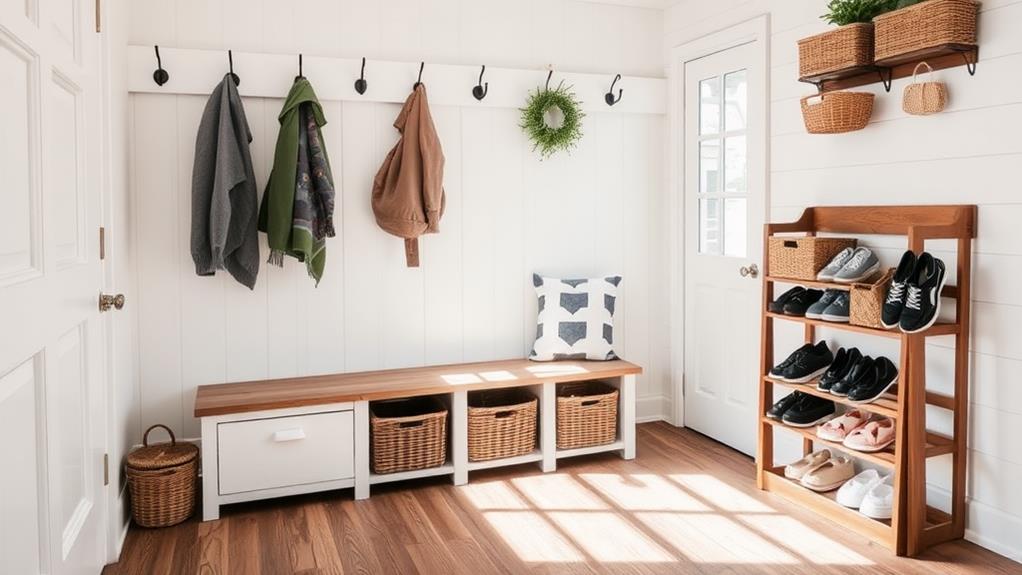
Considering the high-traffic nature of entryways, durable and cost-effective flooring options are essential for a functional space on a budget. Vinyl flooring stands out as an excellent choice, offering a wide range of designs that mimic more expensive materials like hardwood or stone at a fraction of the cost. It's easy to clean, water-resistant, and can withstand heavy foot traffic.
Another budget-friendly option is laminate flooring, which provides durability and a variety of styles. It's resistant to scratches and stains, making it ideal for busy entryways. For a more natural look, consider cork flooring. It's eco-friendly, comfortable underfoot, and has natural antimicrobial properties.
Ceramic tiles are also worth considering, as they're long-lasting and easy to maintain. Opt for textured or matte finishes to reduce the risk of slipping. For a DIY approach, painted concrete can be an inexpensive yet stylish solution. Simply clean the existing concrete floor, apply a concrete primer, and use epoxy paint to create a durable, customized surface.
Regardless of the chosen material, ensure proper installation and regular maintenance to maximize the lifespan of your budget-friendly flooring, keeping your entryway functional and attractive for years to come.
Lighting for Functionality
Illumination plays a crucial role in creating a functional entryway on a budget. Proper lighting enhances visibility, safety, and the overall ambiance of the space. To maximize functionality without breaking the bank, consider a combination of natural and artificial light sources.
Start by utilizing any existing windows or glass panels in doors to allow natural light to flood the area during daytime hours. For artificial lighting, opt for energy-efficient LED bulbs in fixtures that provide ample brightness. A centrally-placed ceiling light or flush-mount fixture can serve as the primary light source, while wall sconces or recessed lights can add depth and eliminate shadows in corners.
Task lighting is essential for specific areas like shoe storage or coat hooks. Install battery-operated, adhesive-backed LED puck lights under shelves or in closets for targeted illumination. Motion-activated lights are another budget-friendly option, particularly useful for nighttime entry. For a touch of style and additional functionality, consider a small table lamp on a console or shelf.
When selecting fixtures, choose versatile designs that complement your decor while prioritizing practicality. Look for sales, secondhand options, or DIY alternatives to keep costs down without sacrificing quality and functionality in your entryway lighting setup.
Frequently Asked Questions
How Do I Keep My Mudroom Clean and Odor-Free?
To maintain a clean and odor-free mudroom, implement regular cleaning routines, use moisture-absorbing mats, provide adequate ventilation, utilize deodorizers, and employ storage solutions for shoes and wet items. Promptly address spills and encourage family members to remove dirty footwear.
What's the Best Way to Organize Shoes for a Large Family?
While shoe racks may seem sufficient, they often fall short for large families. Instead, consider installing a combination of cubbies, open shelving, and labeled baskets. This versatile system accommodates various shoe sizes and styles while keeping everything organized and easily accessible.
Can I Create a Mudroom in a Small Apartment?
Creating a mudroom in a small apartment is possible with creative space utilization. Consider using vertical storage solutions, multi-functional furniture, and designated zones for shoes and outerwear. Wall-mounted organizers and compact benches can maximize limited space effectively.
How Do I Childproof My Mudroom While Keeping It Functional?
To childproof your mudroom while maintaining functionality, implement secure storage solutions, use rounded-edge furniture, install safety locks on cabinets, and ensure proper organization. Consider non-slip flooring, sturdy hooks at child-appropriate heights, and cushioned seating for added safety and practicality.
What Are Some Eco-Friendly Materials for Mudroom Construction and Organization?
For eco-friendly mudroom construction and organization, consider using reclaimed wood, bamboo flooring, recycled plastic storage bins, organic cotton textiles, and low-VOC paints. Incorporate natural fiber mats, upcycled furniture, and energy-efficient LED lighting to enhance sustainability.
Conclusion
In conclusion, transforming a mudroom into a functional entryway need not break the bank. By strategically assessing space, maximizing storage, and incorporating multi-purpose elements, homeowners can create an organized oasis that weathers the storm of daily life. DIY solutions and budget-friendly options for flooring and lighting further enhance the space's utility. With careful planning and creativity, even the most modest entryway can blossom into a well-orchestrated symphony of style and practicality, setting the tone for the entire home.
